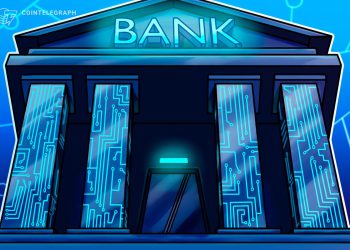Tokenized deposits and stablecoins may sound like the same thing, given that they are both fiat-on-chain. But they are actually distinct concepts, and the difference matters not just for use cases and our understanding of blockchain potential, but also for how regulation can evolve. They also both highlight, in different ways, how our understanding of money is changing.
Noelle Acheson is the former head of research at CoinDesk and Genesis Trading, and host of the CoinDesk Markets Daily podcast. This article is excerpted from her Crypto Is Macro Now newsletter, which focuses on the overlap between the shifting crypto and macro landscapes. These opinions are hers, and nothing she writes should be taken as investment advice.
Tokenized deposits, sometimes known as deposit tokens, are blockchain representations of fiat currency bank deposits. They are issued by banks, backed by fiat deposits at those banks, and can run on either private or public blockchains (although, since these are heavily regulated entities, they’ll want complete control of access). In some cases, such as with JPMorgan’s JPM Coin, they are used to settle transactions between JPMorgan clients. In others, such as SocGen’s EURCV, they can be transferred to clients who do not have accounts at the issuer bank, but only after being whitelisted.
Tokenized deposits boost the efficiency of fiat by eliminating some steps in the execution of trade and settlement, while enhancing transparency and flexibility for their issuers.
Reserve stablecoins*, on the other hand, are blockchain tokens backed by a fiat currency. The issuer, which may or may not be a bank, promises to maintain the value of the token stable relative to the chosen fiat by allowing redemption at any time. (*Other types of “stablecoins,” such as algorithmic and yield-bearing, are different enough to be left out of this consideration for now.)
This may sound like a tokenized deposit, but it’s not. The stablecoin doesn’t represent the deposit, it is pegged to the fiat value via the backing reserves: a small distinction that makes a big difference.
The difference is operational, conceptual and legal.
On the operational side, the transfer of a deposit token from one client to another usually triggers an off-chain transfer of fiat from one account to another. The tokens represent bank deposits, so the fiat account balances in theory have to match the token account balances.
Stablecoins, on the other hand, don’t involve adjusting fiat accounts in the background. They freely change hands between users, and the underlying reserve account doesn’t need to care. It just needs to be available for redemption on demand, it doesn’t matter by whom (this is a slight simplification as not everyone can redeem, but not a significant one – those who don’t redeem can exchange stablecoins for fiat on a number of platforms).
This leads us to the conceptual difference. Deposit tokens are designed to be a more liquid version of traditional deposits, not a substitute. They are not meant to replace fiat money, just make it more efficient.
Stablecoins, however, are more like a substitute. They were originally created as a way to avoid the need for fiat, back in the early days when crypto exchanges couldn’t get bank accounts. They rapidly became not just a workaround but a more efficient way (faster, cheaper) to move funds to and between exchanges, often preferred even when fiat onramps are available.
Deposit tokens are created by banks, for bank clients. They represent bank deposits.
Stablecoins were originally created for those who could not get bank accounts. They are a bank deposit substitute. They represent value, not a commercial arrangement.
What’s more, stablecoins are bearer instruments: whoever holds them, owns them. They are the asset.
Deposit tokens are not bearer instruments. They represent the asset, in this case, named deposits at a bank.
This brings us to the likely legal evolution of the two concepts. In principle, from the regulator’s point of view, bank deposit representations are fine, bank deposit substitutes are more problematic.
Here is where it gets particularly interesting, and where the two concepts unexpectedly start to blend.
Here is also where it gets philosophical.
One of the underlying principles of money is its “singleness”, where a dollar is a dollar (to pick one currency), no matter who holds it or how. This is one of the reasons regulators want to control the issuance of dollars, to guarantee that one of the basic assumptions of monetary law will always hold. In a world with multiple dollar issuers and no central guarantor, perhaps not all dollars would be equal.
As we have seen, stablecoins don’t always fulfill “singleness.” One USDT or one USDC (to pick the two largest examples) are not always equivalent to one dollar, although they tend to revert to the underlying value. Therefore, regulators technically cannot consider them “money.” Plus, Tether (issuer of the market’s largest stablecoin USDT) is not insured by the FDIC, therefore the guarantees behind 1 USDT are not the same as those behind $1, which in theory could impact the monetary value.
So, what are stablecoins, then, if not “money”? Securities, along the lines of tradeable money market funds? That would be kind of weird because they are used as money, and they for sure don’t satisfy the Howey test prong of “expectation of profit.” “Common enterprise,” another Howey prong with success tied to a promoter or investor pool, would also be tough to prove.
What’s more, stablecoins fulfill the “establishment” definition of money: they settle transactions, they are widely accepted, they are the unit of account for many assets, they hold their value over time.
But they break the singleness requirement, which is a big deal for regulators who decide who can legally issue and use them.
And if they end up being classified as securities because of that lack of singleness, along the lines of non-yielding money market funds, then we have a melding of previously distinct concepts that could open up a deeper shift in how finance works. Securities, via stablecoins, could become a widely accepted money substitute.
Okay, so deposit tokens could be considered money in the eyes of regulators, stablecoins bewilderingly not, right? Not so fast.
Deposit tokens may represent money, but that doesn’t mean they are, legally. For one, they are subject to different types of risk. Bank deposits are not actually all there – most are lent out or invested. So, in the event of a bank collapse, it could turn out that the deposit tokens don’t have the backing everyone thought. The same holds for deposits, but they’re usually at least partially insured. Tokenized deposits, for now, are not.
And a technological glitch could lead to payment misses or even duplication, possibly leading to the deposit token balances not matching the fiat account balances. How would that get resolved, and who would decide?
Furthermore, some innovative bank thinkers talk about the potential to introduce programmability to deposit tokens, enhancing their efficiency and flexibility. Conditional payments are more a wallet question. But it’s not a huge leap to imagine a deposit token that includes a snippet of code that triggers a function, such as access to a bid or payment of a dividend.
This sounds very cool, but it changes the characteristics of the deposit tokens to something more than mere money representation. If a token can become something else, is it still money? Does it satisfy the “singleness” requirement? Does it comply with the establishment definition criteria of medium of exchange, store of value and unit of account?
My hope is that the conundrums presented by the eruption of a new type of transfer technology into the powerful yet limited reach of “old school” monetary economics will open more eyes to the need to update definitions and concepts.
As things stand, regulators are held back by a blinkered adherence to past understanding, refusing to accept that new technologies require new ways of thinking. By limiting “acceptable” uses to things we can already do, authorities are blocking real innovation from helping to both cement and improve on progress.
This brings to mind a quote attributed to Stanford Professor Paul Saffo: “We tend to use a new technology to do an old task more efficiently. We pave the cow paths.”
Surely we can do better, but the first step will be to recognize that the new flying cows no longer need paths, existing definitions of money are unnecessarily limited, and regulators that stand in the way of progress become increasingly irrelevant.
Note: The views expressed in this column are those of the author and do not necessarily reflect those of CoinDesk, Inc. or its owners and affiliates.

























